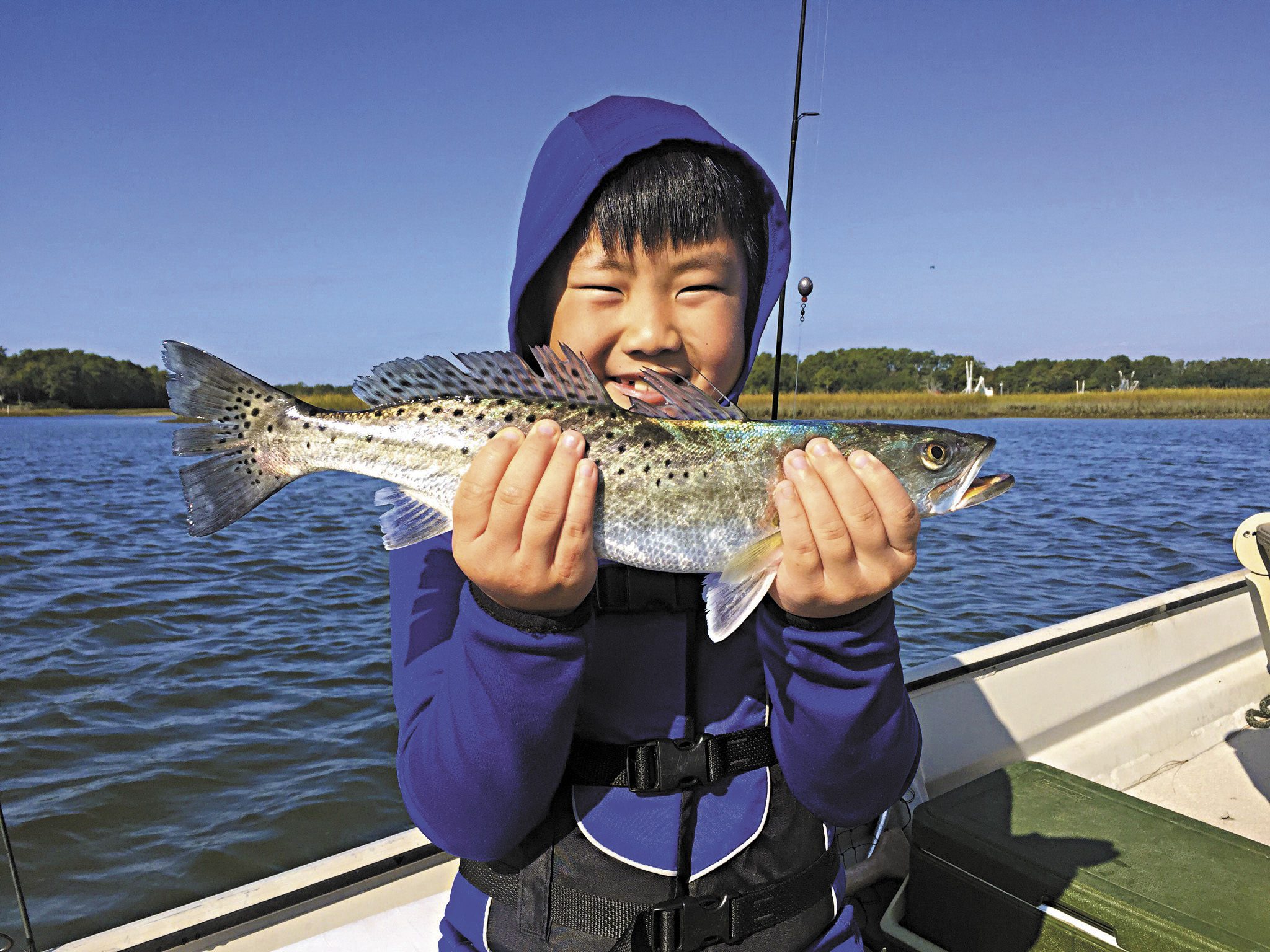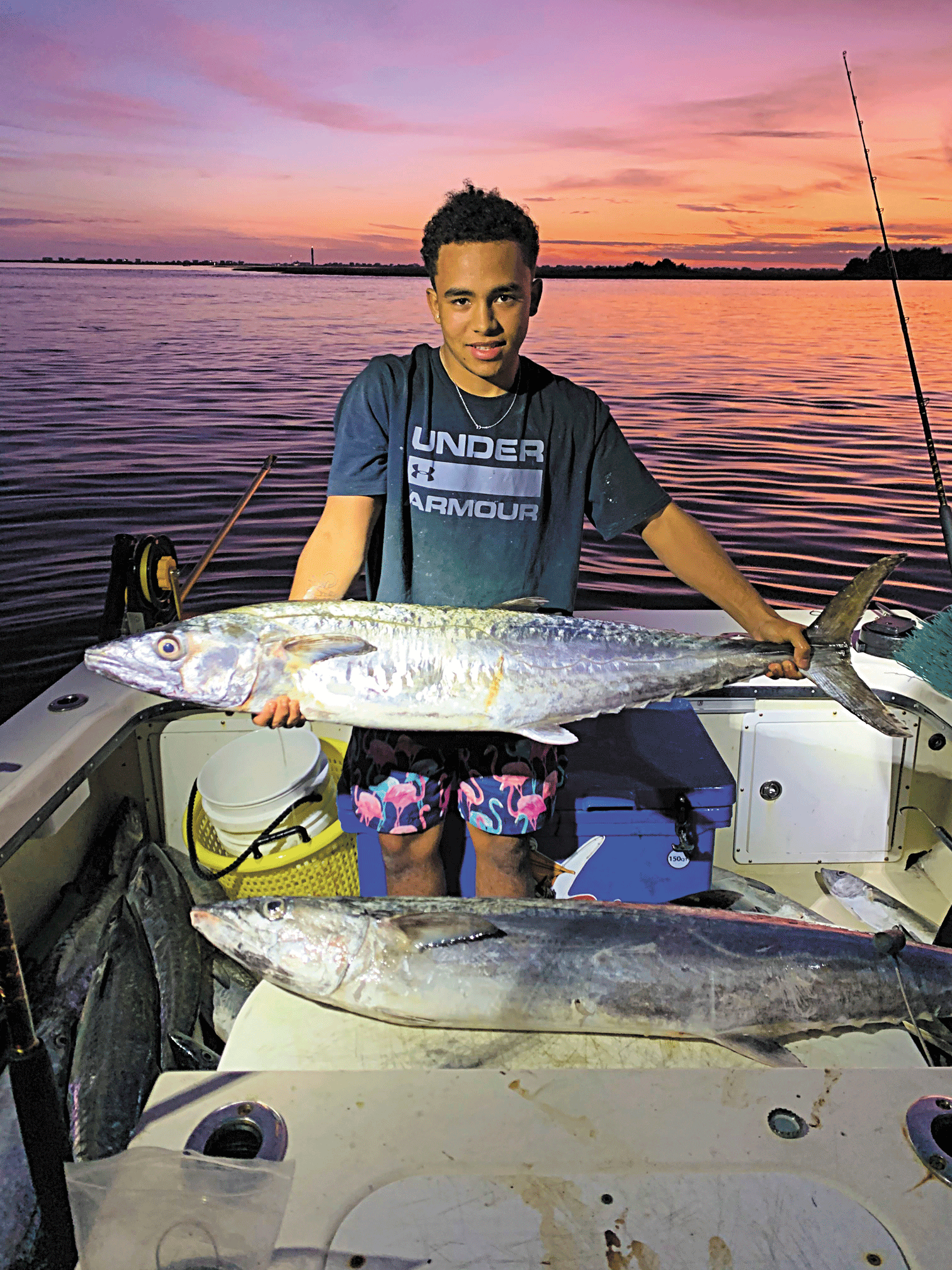Southport/Oak Island – Winter 2019-2020
Annette, of Dutchman’s Creek Bait and Tackle, reports that anglers working the surf zone have found solid numbers of whiting. Fresh cut shrimp and Fishbites, specifically bloodworm and shrimp, on a bottom rig have been doing the trick. Anglers tossing cut mullet have also picked up a bonus red drum or two.
Inshore, speckled trout are everywhere in the ICW, and they’re working their way into the creeks. MirrOlure MR17s in the electric chicken color have been everyone’s go-to lure.
Red drum are being found in the same areas as the trout. They will also take a MirrOlure, but the reds more often find it hard to turn down a soft plastic on a 3/16 or 1/4 oz. jig head. However, when you can get live shrimp and mud minnows, they’ve been producing more numbers of fish than any artificial.
Black drum are the other main species you’ll find with the trout and reds. The black drum tend to prefer cut or live shrimp fished on the bottom using a Carolina rig. Docks and marsh banks are good places to start looking for these fish.
Nearshore, there are still some schools of citation red drum along the beaches.
Looking forward, trout, redfish, and black drum will stick around and continue to feed on the same baits as they are feeding on now. Live mud minnows will replace live shrimp, as the shrimp get harder to find. Fishing mud minnows under float rigs can best tempt some of these cold fish to feed, as will slowly working a MirrOlure MR17.
Spots around Davis Canal and up into the feeder creeks off the ICW will hold the majority of the inshore fish for the next couple months.

Anderson H. (age 8) with a 19″ speckled trout caught while fishing with his grandpa in the Shallotte River using fresh shrimp.
Tim, of Wildlife Bait and Tackle, reports that the speckled trout bite is on fire, along with consistent red drum action.
Grouper are between 25-30 miles offshore, and keeper black sea bass should start firing up soon. The winter months will also continue to feature wahoo, king mackerel, triggerfish, and both blackfin and bluefin tuna.
Robert, of Reelin’ Pelican Charters, reports that bottom fishing in the area is awesome right now. Grouper, grunts, and beeliners are holding tight to rocks and structure around the 30 mile mark, and large “knot head” black sea bass in the 4-5 lb. range are staging in the Tower area. Whole or cut squid and cut cigar minnows on double loop bottom rigs are working great.
Wahoo are out in the Gulf Stream in good numbers. Ilanders rigged with ballyhoo and black/purple Fathom lures on a planer are the top producers. Watching your finder and pulling rigs at the same depth where you see bait is going to be key in finding success.
Mahi and blackfin tuna are in schools and looking for baits alongside the wahoo. Smaller feathers rigged with ballyhoo is the most popular tactic.
Speckled trout and redfish are holding in the creeks off the ICW. Artificial baits, such as soft plastics on 1/4 or 3/16 oz. jig heads, are producing. As winter progresses, hard suspending baits and lighter jig heads fished slowly will be helpful in getting bites. The cold water slows the movement of the trout, and they won’t have energy to chase a bait moving too fast.
Sheepshead are taking fiddler crabs fished tight to hard bottom and structure. Look for areas of fast current to produce some of the bigger fish.

Jalen Parker, from Southport, NC, with a 39 lb. king mackerel caught 30 miles off Southport. He was fishing with Capt. Robert Capps of Reelin’ Pelican Fishing Charters.
Mark, of Angry Pelican Charters, reports that speckled trout fishing has been outstanding, with limits of keepers and some citation-sized fish in the mix. There are also a lot of juvenile fish in the backwater creeks, which should make for some great fishing next spring. High Water Lure soft plastics on 1/8-1/2 oz. jig heads are getting the job done, thanks to their unique paddle tail design, and MirrOlure MR17s and 18s are working as well.
Increase your chances of getting a big fish by focusing on the moving water just before and after the tide changes. You will also have a good chance of finding a keeper redfish in the same areas.
Fishing for whiting at the mouth of the Cape Fear River is outstanding this time of year.
The king mackerel bite has been great. Finding warmer water in the 20-30 mile range has been the key to finding good numbers of quality fish. Over the next couple months, the Horseshoe and Frying Pan Tower areas will continue to be productive. Look for significant temperature breaks in these areas and the bait that concentrates there. Jigging cigar minnows and slow trolling are both options, but dead baits behind Pirate plugs or Blue Water Candy shovels will get the job done as well. To cover more ground, try pulling Drone spoons on deep diving planers.
Large false albacore and the occasional blackfin tuna will be feeding in the same areas. Using the same tactics for the kings on the falsies will prove effective in generating strikes.
Bottom fishing in depths greater than 75-80+’ should be excellent over the next couple of months. Using live or cut baits and fishing close to structure, ledges, wrecks, and live bottoms will do the trick.
The Gulf Stream should be producing wahoo, blackfin tuna, and a few scattered dolphin. Medium ballyhoo is likely to do the trick over live bottoms or ledges in 120-200’ of water. High speed lures (like a Big Nic Dinner Bell) will allow you to cover a lot of ground, but don’t spend too much time in any water deeper than 220’.
Bottom fishing in depths of 90+’ should be excellent over the winter months, with black sea bass, grouper, and triggerfish filling boxes. A variety of cut baits, live pinfish, or cigar minnows will draw strikes, but vertical jigs tend to produce larger fish. Being right on top of a rock, ledge, or wreck is extremely important this time of year, so don’t be afraid to move around.
Ryan, of Fugitive Charters, reports that the king mackerel have still been the main target offshore, with big numbers of fish located mostly in the 25 mile range. Kings of all sizes (from the good eating, smoker-size up to 45 lbs.) are being caught.
Bottom fishing has also been productive. Grouper, snapper, and triggerfish are feeding feverishly on cut cigar minnows. Look for good bottom in the 30-35 mile range for these fish.
Inshore, speckled trout have been on fire. The trout have been found from the inlet up into the creeks, and they are quick to jump on live shrimp or shrimp-imitation lures.
Redfish and flounder are mixed in with the trout, and they are also ready to pick up a live shrimp or a Gulp soft plastic.
Through the next couple of months, the inshore bite will be focused on trout and redfish.
Offshore, the king bite will provide action during good weather windows. The kings will push a little further offshore with the falling water temps, usually out to the Tower area. Generally, 35-40 miles is a good starting point as you search for water in the 67-69 degree range.
Wally, of Oak Island Charters, reports that the trout fishing has been great in the creeks and backwaters in the area. Many are keeper-sized fish, and they can be hooked on live shrimp under a cork.
Heading into winter, the trout bite should continue until it gets really cold, and then the main bite in the inshore waters will turn to black and red drum. Throw out a piece of cut shrimp to snag the winter drum.
Offshore, the wahoo fishing should be good for those wanting to troll.
Sherry, of Oak Island Pier, reports that anglers are bringing in whiting and croakers on live shrimp.
Moving into the winter, anglers generally see some pufferfish show up.





